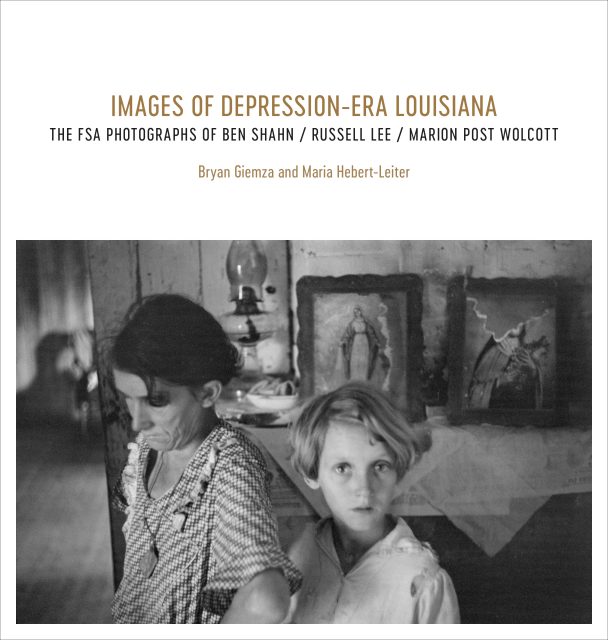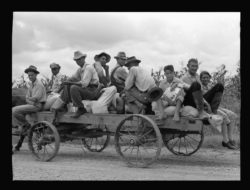Review
The Historical Section
Photographs of Depression-era Louisiana capture a state on the verge of great change
Published: December 8, 2017
Last Updated: December 7, 2018

Mullatoes returning from town with groceries and supplies near Melrose, Natchitoches Parish, Louisiana, by Marion Post Wolcott, 1940.
The Resettlement Administration (RA) was among the more startlingly socialist of the federal initiatives. Led by economist Rexford Tugwell, a member of Franklin Roosevelt’s “brain trust,” the short-lived project established cooperatives where farming families could lease land and share in the collective’s profits. Soon after the establishment of RA in 1935, Tugwell recruited Roy E. Stryker, his former student at Columbia University, to head the Historical Section, a slightly Orwellian-sounding department charged with engendering popular support for RA by documenting the needs of struggling Americans through photographs published in newspapers, magazines, and books. In its first annual report, the department noted that, along with keeping a record of RA projects, the agency was also “perpetuating photographically certain aspects of the American scene which may prove incalculably valuable in time to come.” A new collection from Louisiana State University Press leaves little doubt about the lasting importance of the work of Stryker and the photographers he sent to Louisiana.
Images of Depression-Era Louisiana focuses on the three most prolific photographers working in the state from 1935 to 1941: Ben Shahn, a Lithuanian immigrant who toured the Mississippi Delta in a Model A, accompanied by his girlfriend; Russell Lee, son of a wealthy Illinois farming family, who took special joy in visits to the state fair in Donaldsonville and the Crowley Rice Festival; and Marion Post Wolcott, a New Jersey native known for the personal connections she forged with her subjects. Together, the photographers took hundreds of photographs in the state, with Lee and Wolcott far outpacing Shahn. The book’s editors, Bryan Giemza and Maria Hebert-Leiter, selected 168 photos, 147 by the trio and the rest from other photographers who worked in Louisiana for the Historical Section, including Walker Evans and Dorothea Lange.
The photographs resound with that almost indescribable paradox that persists to this day—the richness of life in our poverty-stricken state.
Government funding enabled the photographers to capture the state using the latest advances in technology (flashbulbs, fast film, and filters), with Stryker providing editorial direction and on-the-ground contacts. Shahn, Lee, and Wolcott traveled widely in Louisiana and around the country, employing their own artistic voices and techniques to the delight and occasional ire of their boss. “You have done many pictures of the families standing in front of their house or shack. They appear a bit stiff in this manner,” Stryker wrote to Lee after reviewing negatives of a visit to Iowa.
In Louisiana, stiffness was rarely an issue. Shahn finds a crowd of children gathered around a bear on a New Orleans sidewalk. Lee walks with two traveling evangelists as they push their cart between the towns of Lafayette and Scott. Wolcott looks over the shoulders of two boys fishing in Schriever. We’re reminded of ways of life that passed with the last century, and the traditions that persist. Louisianans gather at funerals and dancehalls; boys sit on a sack of oysters in Olga; a musician cradles his accordion in the backseat of a car near New Iberia. If the photographs were meant to rally support for the nation’s struggling poor, they also resound with that almost indescribable paradox that persists to this day—the richness of life in our poverty-stricken state.
Yet as much local color as these black and white photos express, what also stands out is the stark segregation. We rarely see a photo of white and black Louisianans together. The photographers were responsible for captioning their work and, for the most part, they identified whites by name while blacks were “colored” or “mulattoes.” Resettlement was itself a problematic initiative. Three farming collectives were set up in Louisiana, including the Transylvania Project near Lake Providence. African-American families who had farmed the fertile land for more than a hundred years were forced out to make way for the all-white project. Lee captures the wary stare of a man holding a baby under the caption: “Negro sharecropper and child who will be resettled, Transylvania Project, Louisiana.”
One wonders what a similarly ambitious survey would reveal about Louisiana in 2017. As the editors note, the images exposed Louisiana and the Deep South “to the rest of the nation and made them more familiar, consequently preparing the way for assimilation in the coming years.” Today much of America knows Louisiana’s unique cultures through reality television, while government funding for more dignified documentation is on the wane. The hardships remain, as do the vivid differences that make the state attractive to more sensational treatments. Images of Depression-Era Louisiana offers a sweeping view of a Louisiana not so unlike our own, standing on the precipice of great changes, all the while fighting to keep its head above water and its traditions intact.
—
Brian Boyles is the publisher of Louisiana Cultural Vistas.

